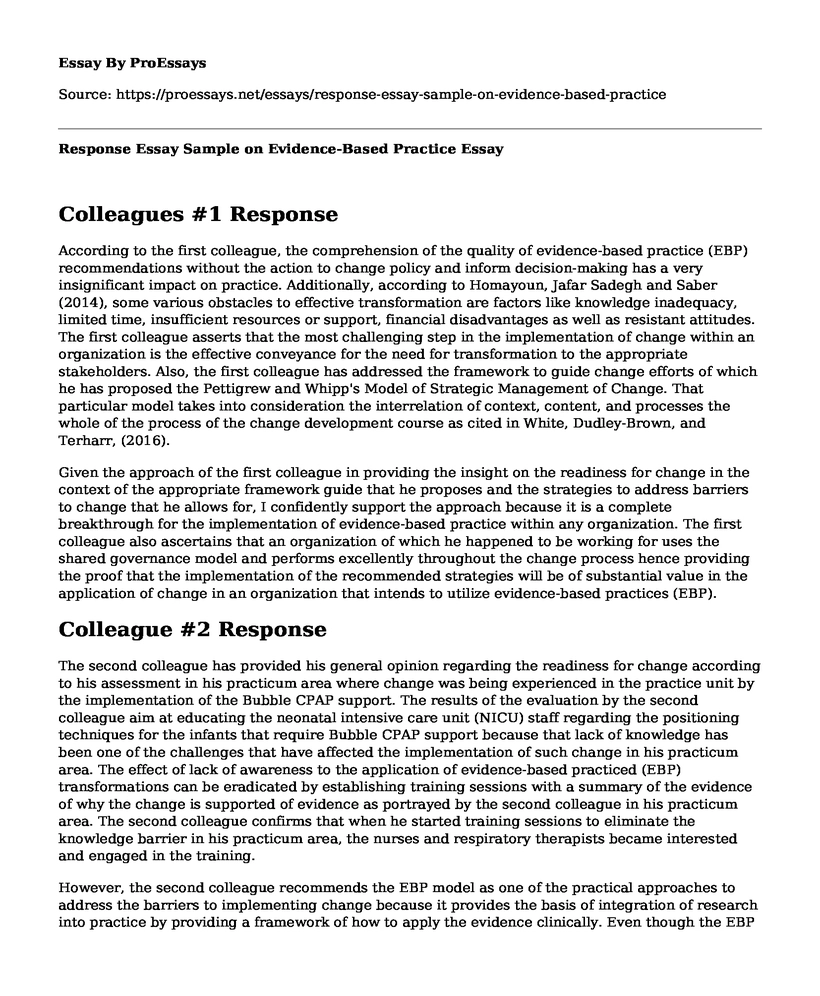Colleagues #1 Response
According to the first colleague, the comprehension of the quality of evidence-based practice (EBP) recommendations without the action to change policy and inform decision-making has a very insignificant impact on practice. Additionally, according to Homayoun, Jafar Sadegh and Saber (2014), some various obstacles to effective transformation are factors like knowledge inadequacy, limited time, insufficient resources or support, financial disadvantages as well as resistant attitudes. The first colleague asserts that the most challenging step in the implementation of change within an organization is the effective conveyance for the need for transformation to the appropriate stakeholders. Also, the first colleague has addressed the framework to guide change efforts of which he has proposed the Pettigrew and Whipp's Model of Strategic Management of Change. That particular model takes into consideration the interrelation of context, content, and processes the whole of the process of the change development course as cited in White, Dudley-Brown, and Terharr, (2016).
Given the approach of the first colleague in providing the insight on the readiness for change in the context of the appropriate framework guide that he proposes and the strategies to address barriers to change that he allows for, I confidently support the approach because it is a complete breakthrough for the implementation of evidence-based practice within any organization. The first colleague also ascertains that an organization of which he happened to be working for uses the shared governance model and performs excellently throughout the change process hence providing the proof that the implementation of the recommended strategies will be of substantial value in the application of change in an organization that intends to utilize evidence-based practices (EBP).
Colleague #2 Response
The second colleague has provided his general opinion regarding the readiness for change according to his assessment in his practicum area where change was being experienced in the practice unit by the implementation of the Bubble CPAP support. The results of the evaluation by the second colleague aim at educating the neonatal intensive care unit (NICU) staff regarding the positioning techniques for the infants that require Bubble CPAP support because that lack of knowledge has been one of the challenges that have affected the implementation of such change in his practicum area. The effect of lack of awareness to the application of evidence-based practiced (EBP) transformations can be eradicated by establishing training sessions with a summary of the evidence of why the change is supported of evidence as portrayed by the second colleague in his practicum area. The second colleague confirms that when he started training sessions to eliminate the knowledge barrier in his practicum area, the nurses and respiratory therapists became interested and engaged in the training.
However, the second colleague recommends the EBP model as one of the practical approaches to address the barriers to implementing change because it provides the basis of integration of research into practice by providing a framework of how to apply the evidence clinically. Even though the EBP model appears to be a practical approach as well just as recommended by the second colleague, the shared governance model supported by the first colleague seems to be a more agile approach, unlike the EBP model that is strictly only applicable to the clinical context. The EBP model as recommended by John Hopkins is a fundamental approach in educating nurses hence eradicating the knowledge barrier to the implementation of changes, particularly within a clinical organization. John Hopkins also gives the model structures to enable the advanced practice provider during the execution of EBP changes after the identification and addressing of barriers in practice change (Newhouse, Johns Hopkins University, Sigma Theta Tau International and Johns Hopkins Hospital, 2007).
References
Homayoun, S.-B., Jafar Sadegh, T., & Saber, A.-A. (2014). Barriers to evidence-based medicine:
Newhouse, R. P., Johns Hopkins University, Sigma Theta Tau International, & Johns Hopkins Hospital. (2007). Johns Hopkins nursing evidence-based practice model and guidelines. Indianapolis: Sigma Theta Tau International.
White, K. M., Dudley-Brown, S., & Terharr, M. F. (2016). Translation of evidence into nursing and health care practice (2nd ed.). New York, NY: Springer.
Cite this page
Response Essay Sample on Evidence-Based Practice. (2022, Nov 11). Retrieved from https://proessays.net/essays/response-essay-sample-on-evidence-based-practice
If you are the original author of this essay and no longer wish to have it published on the ProEssays website, please click below to request its removal:
- Paper Example on Benefits of Information Health Systems
- The Concepts of Health, Disability, Illness and Behaviour Research Paper
- Problem Solution Essay on Unhealthy Eating Habit
- Caring Angel Hospital HealthCare Policy Essay Example
- Adults: Vaccines Essential for Improved Health & Disease Prevention - Essay Sample
- Essay Example on CBT: An Effective Treatment for Depression & Its Related Conditions
- Paper Example on Age-Related Changes: Nutritional Challenges & Health Risks







